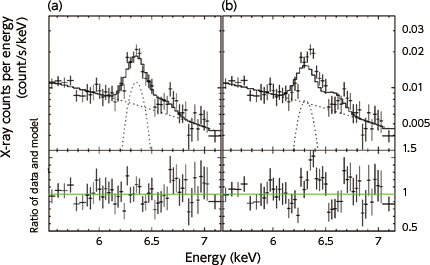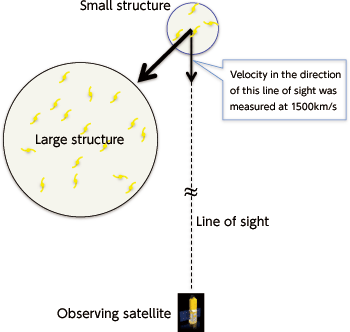TOP > Report & Column > The Forefront of Space Science > 2012 > Dynamics in a Galaxy Cluster Explored by SUZAKU
![]()

Discovery by SUZAKU In January 2006, Assoc. Prof. Kiyoshi Hayashida of Osaka University, et al. proposed the long-time observation of galaxy cluster A2256 in the Little Dipper using the Japanese X-ray astronomical satellite SUZAKU. A2256 has two plasma structures (large and small ones) and is a typical "merging galaxy cluster". By using the X-ray CCD onboard SUZAKU, the observation team aimed to measure the Doppler Effect of the X-ray bright lines from the galaxy cluster's plasma. With this observation, we tried to measure the velocity (in the direction of line of sight connecting the earth and the cluster) of the two plasma structures. A similar measurement had been tried before SUZAKU, but the accuracy had not been satisfactory. After fully examining the performance of SUZAKU's detector, we attempted this difficult measurement. Following the observation in November 2006, Masaaki Nagai, a graduate student of Osaka University at that time, analyzed the data and identified that the velocity difference between the two plasma structures was 1600±700km/s. After a while, the analysis for energy calibration of the detector proceeded and we became confident that we could obtain enough accuracy. The author consulted with Hayashida and reanalyzed the data with Shutaro Ueda, a graduate student of Osaka University. We carefully examined the uncertainty to obtain the correct measuring values. As a result we were able to reduce the uncertainty further and concluded that the velocity difference between the two structures, large and small galaxy clusters, was 1500±300km/s (Fig. 1). These structures are colliding at a high speed and we anticipate that they will merge several hundreds of millions later (Fig 2). 

This is the first time in the world that the velocity difference of galaxy cluster plasmas has been measured using the Doppler Effect. The measurement becomes possible because SUZAKU has the world's highest level of accuracy in CCD sensitivity and energy determination, which was achieved by the steady efforts of a number of researchers engaged in development and calibration of the satellite and detector.
|
||||||||||




